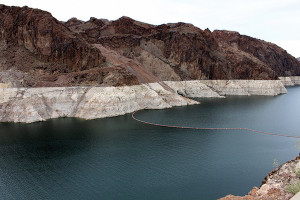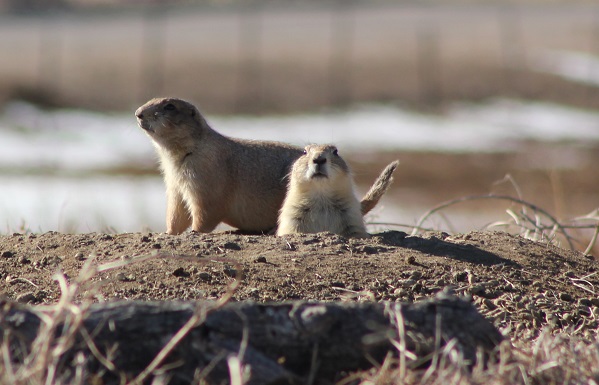Lake Mead watch: six inches from the level that triggers cutbacks
8 Jul
I guess you could file this under “No Shit”. Regardless of whether drought occurs, over-allocation and the cancerous growth that is industrial civilization would create the same shortages.
Deep Green Resistance chapters across the Southwest have declared water preservation and justice as our primary focus for activism. Will you join us in dismantling the systems that would leave our planet dry and lifeless?
Lake Mead watch: six inches from the level that triggers cutbacks
If water curtailments go into effect, which states are most vulnerable, and why?
Sarah Tory June 17, 2015
Record rain across much of the West in May has provided Lake Mead with a much-needed boost – alleviating concerns about possible cutbacks in water deliveries from the nation’s largest reservoir. But a month of rain does not solve Mead’s falling water levels. For nearly two decades, the reservoir, which straddles the Arizona-Nevada border, has been shrinking due to prolonged drought and over-allocation. Mead hasn’t been full since 1998 at 1,221 feet above sea level and in the past 15 years alone, it has dropped 135 feet. Now it’s 37 percent full and just six inches away from reaching the 1,075-foot threshold that triggers cutbacks in deliveries for the three lower basin states – Arizona, Nevada and California – all of which depend heavily on Colorado River water stored in Lake Mead. (The trigger point doesn’t apply to the Upper Basin states of Wyoming, Colorado, Utah and New Mexico.)
But as long as the surface level is at least 1,075 feet above sea level when crucial measurements are taken in January 2016, those cutbacks will be avoided. If not, the Secretary of the Interior will declare a shortage in Lake Mead and the curtailed deliveries, along with other water rationing measures, will go into effect early next year.

Season Martin, Ning Jiang, Julia Morton and Skyler Murphy: //www.hcn.org/articles/what-really-happens-if-lake-mead-stays-below-the-1-075-ft-mark/www.thebathtubring.weebly.com
On June 15, the Bureau of Reclamation predicted that Lake Mead will be at 1,081.58 feet by the end of 2015, above the benchmark level that would trigger water curtailments. That’s an improvement from last month when the Bureau was predicting Mead would be at 1,075.96 feet, said Rose Davis, a spokeswoman for the bureau’s Lower Colorado Region.
So, what happens to the Lower Basin states if the Interior Department declares an official shortage in Lake Mead? According to the Colorado River Interim Guidelines, a 2007 agreement to address water shortages:
Arizona will face the biggest curtailment of annual water deliveries from Lake Mead. Its 2.8 million acre-feet will be cut by 370,000 acre-feet (one acre-foot is enough to supply two average homes for a year), a 13 percent reduction. Farmers who rely on water piped east by the Central Arizona Project, whose water rights are the most junior, will be the hardest hit. Farmers along the western edge of the state who use water from the main stem of the Colorado River won’t be affected by the first round of curtailments. Neither will tribes, industrial users or major cities. Overall the short-term economic impact will be slight, said Michael Cohen, an expert on water use in the Colorado River basin at the Pacific Institute, a water-policy think tank. That’s because Arizona has stored more than 3 million acre-feet of water underground, providing farmers with a back-up supply that will soften the impacts of a shortage.
Next in line is Nevada, which faces a 13,000-acre-feet reduction to its usual 300,000 acre-feet delivery from Lake Mead, a 4 percent cut.
California, meanwhile, can keep withdrawing its full allotment from Lake Mead. This dates back to the negotiations during the ’60s between Arizona and California over the Central Arizona Project, a massive aqueduct that pumps water 336 miles from the Colorado River into central and southern Arizona. To get the project approved by Congress, Arizona needed California’s help. But California saw that at some point there might not be enough water to go around, so it decided to support Arizona’s bid only if Arizona agreed to take more junior water rights.
But California’s deal isn’t as sweet as it sounds. A recent report called ‘The Bathtub Ring’ from graduate students at the University of California, Santa Barbara in conjunction with the Western Water Policy Program, shows that, although California is exempt from the first round of curtailments, 13 million people in Los Angeles are still among the most vulnerable. That’s because the state currently consumes its full Lake Mead allotment and also relies on bonus water it gets through efficiency measures. The program that allows them extra water in exchange for conserving will be put on hold when curtailments go into effect. That means L.A.’s Metropolitan Water District will lose its ability to draw on 662,000 acre-feet annually of surplus water.

Declining water levels in Lake Mead have created its trademark ‘bathtub ring’ around the edge of the reservoir.
Bill and Vicki T/Flickr
Nevada will be largely immune to the first round of delivery cuts from Lake Mead. Though the Southern Nevada Water Authority, which provides for nearly 2 million people in Las Vegas, gets 90 percent of its water from the reservoir, the state gets credit for water it reuses. So if a provider pumps 5,000 acre-feet from the reservoir, but then treats 3,000 acre-feet and returns the treated water to Lake Mead, it’s only on the books for 2,000 acre-feet. Even with the curtailment, the state’s return flow credit program allows Nevada to keep its consumptive water use below its allotted amount.
Should the water levels continue to drop below the 1,075 foot mark, as they are expected to in years to come, more cuts will be required. Below 1,025 feet, the Lower Basin states will have to negotiate new water shortage guidelines.
Sarah Tory is an editorial fellow at High Country News.

No comments yet